19
Risk Assessment
Risk assessment is a vital tool to help you manage health and safety within your organisation. It is a proactive technique which should be undertaken before something goes wrong in order to determine what could cause harm to people. It will help you decide if you have taken sufficient precautions or whether more needs to be done in order to prevent accidents, which could result in injury or ill health. Risk assessments should form an integral part of your overall health and safety management system and be undertaken routinely, systematically and comprehensively. Risks to a person’s health and safety exist in all workplaces, but a well thought out and appropriately applied risk assessment system will greatly help in managing these risks.
The legal requirement to carry out risk assessment is categorised into three legislative groups:
- General – an Act of Parliament which places a broad requirement to reduce risks
- Specific – the legislation that categorically states that a risk assessment must be carried out for certain activities
- Implied – a risk assessment that may be required in order to determine if health and safety provisions are adequate and appropriate
General
- Health and Safety at Work etc. Act 1974:
Employers must, so far as is reasonably practicable, control health and safety risks to which employees are exposed and others who might be affected by any of the organisations’ undertakings.
Specific
- Management of Health and Safety at Work Regulations 1999:
Every employer shall make a suitable and sufficient assessment of the risks to the health and safety of employees to which they are exposed and the risks of others who might be affected. A specific requirement exists to assess the risks to new and expectant mothers and women of reproductive age and young persons.
- Health and Safety (Display Screen Equipment) Regulations 1992 (as amended):
Employers are required to make a suitable and sufficient assessment of the risks connected to workstations used by employees.
- Regulatory Reform (Fire Safety) Order 2005:
Employers must carry out a suitable and sufficient assessment of fire risks to which relevant people are exposed.
- Control of Substances Hazardous to Health Regulations 2002:
Employers are required to make a suitable and sufficient assessment of the risks to health caused by the use of hazardous substances.
- Manual Handling Operations Regulations 1992 (as amended):
Employers are required to make a suitable and sufficient assessment of the risks involved in manual handling operations where it is unreasonable to avoid the need for such activities.
- Ionising Radiation Regulations 1999:
Radiation employers must carry out a suitable and sufficient ‘prior risk assessment’ before commencing a new activity to which employees and others may be exposed.
Implied
- Personal Protective Equipment (PPE):
Employers to identify and provide suitable and appropriate PPE where risks can not be adequately controlled by other means.
- Health and Safety (First Aid) Regulations 1981:
Employers must have adequate and appropriate first aid equipment and facilities, however, the level of provision will depend on the risks present within the organisation.
Additional Legal Requirements
As identified above, there is a vast range of legislation that places a requirement on employers to undertake risk assessments. Employers must also be aware of additional requirements contained within the legislation and understand how to comply.
- A suitable and sufficient risk assessment
- clearly identifies the risks presented and the level of severity;
- provides detail in proportion to the risk;
- considers everyone who may be exposed, both internal and external people;
- states how long the risk assessment will remain valid and current;
- identifies sources of advice for specialised risks.
In summary, the risk assessment must be suitable to the organisation and the activities undertaken and provide sufficient detail to demonstrate compliance.
- Recording risk assessment (Figures 19.1 and 19.2):
Figure 19.1 Situation-based risk assessment template.


Figure 19.2 Activity/task-based risk assessment template.
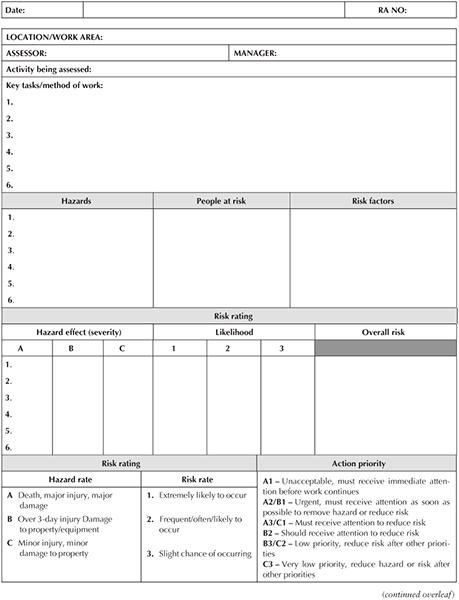
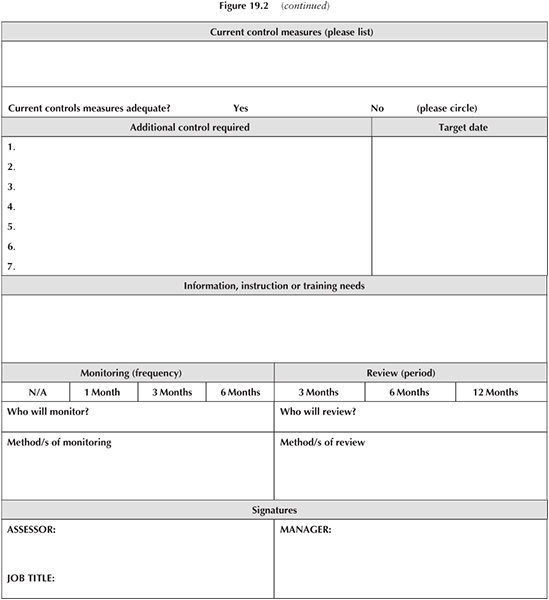
- Where five or more are employed (includes self-employed), significant findings must be recorded.
- Records must show that an adequate and accurate assessment was made.
- There is an understanding of who might be affected.
- All significant hazards were addressed and managed.
- Reasonable precautions were taken to reduce the risk.
- Residual risk levels are as low as is reasonable.
- Employees should be involved in the process.
- Monitoring and reviewing risk assessments (Figure 19.3):
Figure 19.3 Risk assessment monitoring log.
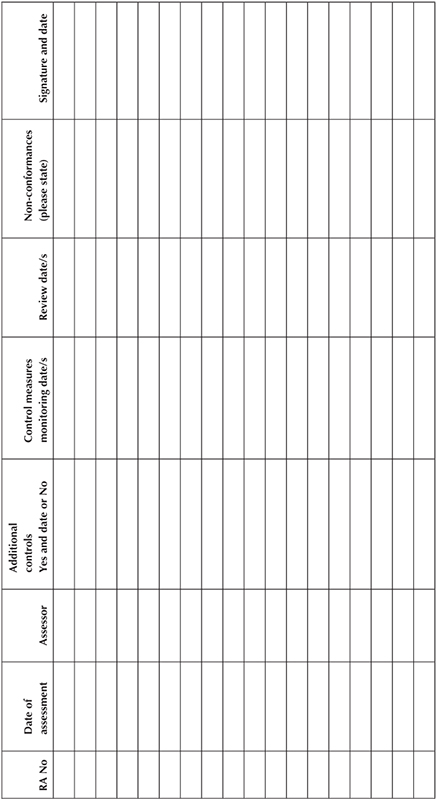
- Control measures are monitored for adequacy and appropriateness and remedial action taken where necessary.
- Review is undertaken where it is suspected that the risk assessment is no longer valid or where changes occur.
Risk assessment is not just about controlling risks to ensure everyone is safe. It goes beyond this by providing a management system that demonstrates commitment to the organisation’s Health and Safety Policy. It achieves this by the following means:
- Identifies hazards, assesses risks and implements controls
- Maintains an awareness of legal and ethical requirements
- Ensures competency of employees
- Demonstrates the communication of health and safety information
- Records significant findings and action taken to manage risks
Definitions
Before attempting to carry out risk assessments, it is important to have an understanding of the key terms used throughout the process.
- Hazard – something with the potential to cause harm; this can be split into two types of hazards: safety and health (Table 19.1).
Table 19.1 Types of hazards
| Safety | Health |
| Slips, trips and falls | Noise levels |
| Lifting and handling | Ionising radiation |
| Use of equipment | Biological agents |
| Fire | Hazardous chemicals |
| Electricity | Thermal environment |
| Sharp edges | Repetitive movement |
| Working alone | Poor lighting |
It must be recognised that a hazard may fall into both categories. For example, when using a hazardous chemical, contact with the skin may cause a burn (safety) or if inhaled it could cause a respiratory condition (health). Leading on from the above two categories, hazards can then be grouped into five categories: biological, chemical, physical, ergonomic and organisational. Figure 19.4 provides examples of each category in relation to new and expectant mothers.
- Risk – the likelihood that the hazard is realised and the severity of harm.
- Extent of risk – calculated by determining several factors, for example, what is the risk, how the harm may be caused, the number of people affected and the severity of the consequences.
- Control measures – the arrangements made to reduce the risk as low as is reasonable.
- Situation-based assessment – assessment of an area or room where the hazard is static but could cause harm to people – for example, inadequate temperature or structural discrepancies (Figure 19.1).
- Activity/task-based assessment – breakdown of a main activity into component tasks, so hazards can be identified at each stage (Figure 19.2).
Figure 19.4 New and expectant mothers’ risk analysis.
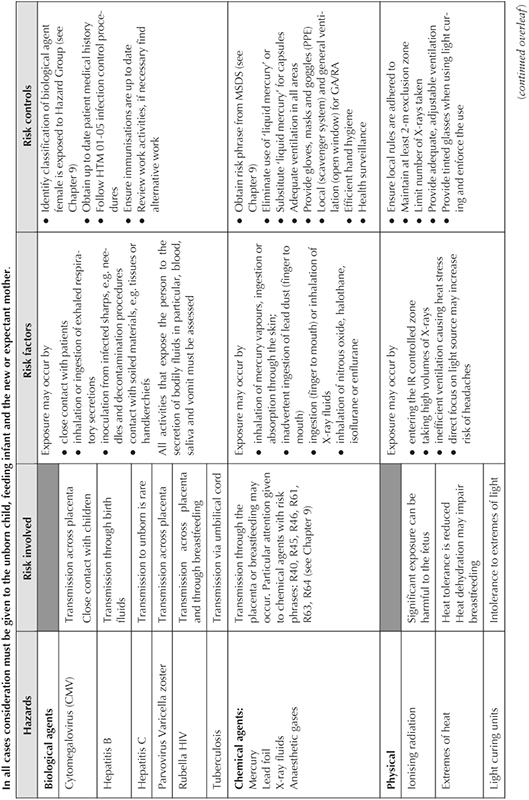
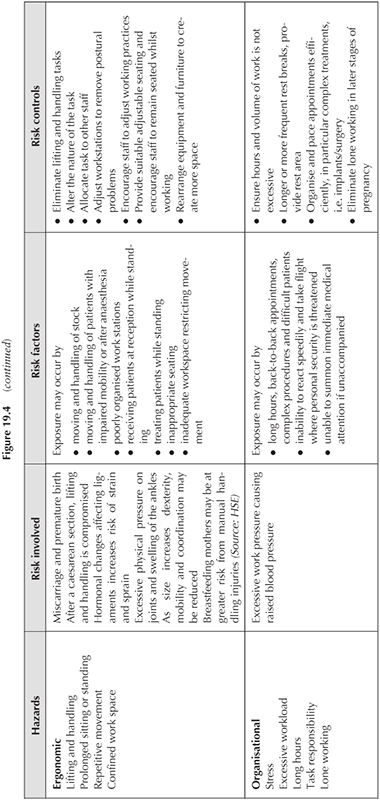
The benefits to the organisation of a properly designed and implemented risk assessment programme are as follows:
- It demonstrates compliance to legal requirements.
- It helps reduce accidents, injuries and ill health.
- It assists the organisation with improving performance standards.
- Staff feel cared for and therefore motivated to work as a team.
- The cost of injuries and ill health are reduced.
- Employers are at less of a risk of claims for compensation.
- It provides vital evidence to prove whether a duty of care has been breached.
- It helps in effective management of resources through a well-structured, planned approach which helps prioritise risks.
- It demonstrates good management practice.
Your risk assessments should be specific to your organisation and clearly show what is present within your workplace that could put people at risk. The risk assessment should be owned by you and show evidence that it is an analysis of your working environment and associated activities. Within the risk assessment framework, there are three main types of risk assessments.
- Generic risk assessment
This type of assessment refers to general activities or common tasks that occur routinely throughout the practice. The activities or tasks are usually specific to a role, for example, dental nurse, and therefore could be undertaken by different people. It is important to identify any particular factors relating to the activity that may require a specific risk assessment to be undertaken.
- Specific risk assessment
This type of assessment falls into two categories.
1. A generic risk assessment may identify that particular factors exist which need to be further analysed and additional precautions taken. For example, the additional factors could be that the person carrying out the task might be inexperienced or is pregnant, the location where work is being undertaken is different or the equipment is different and therefore the risk presented differs from the original assessment.
2. There may be instances where staff perform non-routine tasks or, non-standard functions take place which are not common to the normal day-to-day practice opera/>
Stay updated, free dental videos. Join our Telegram channel

VIDEdental - Online dental courses


